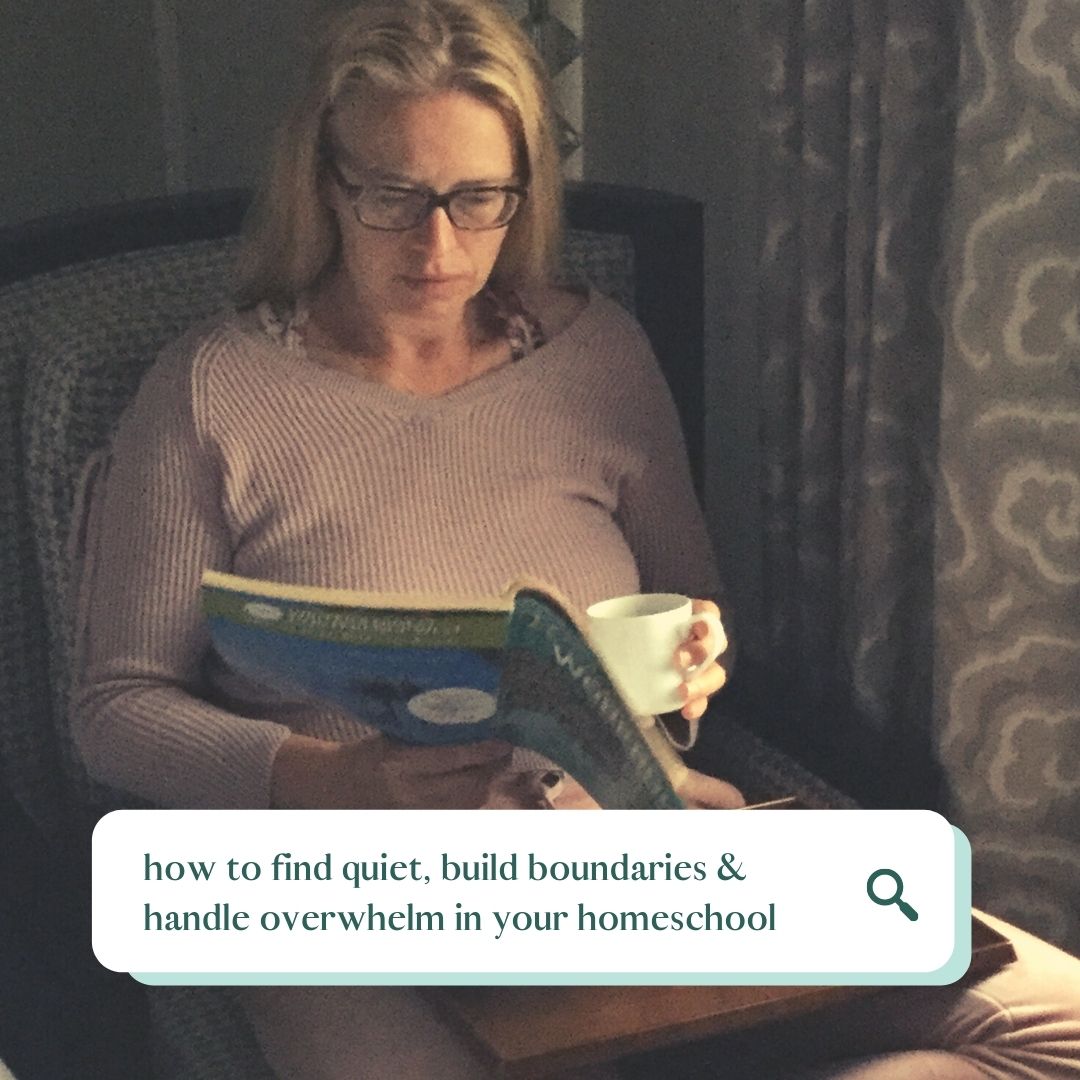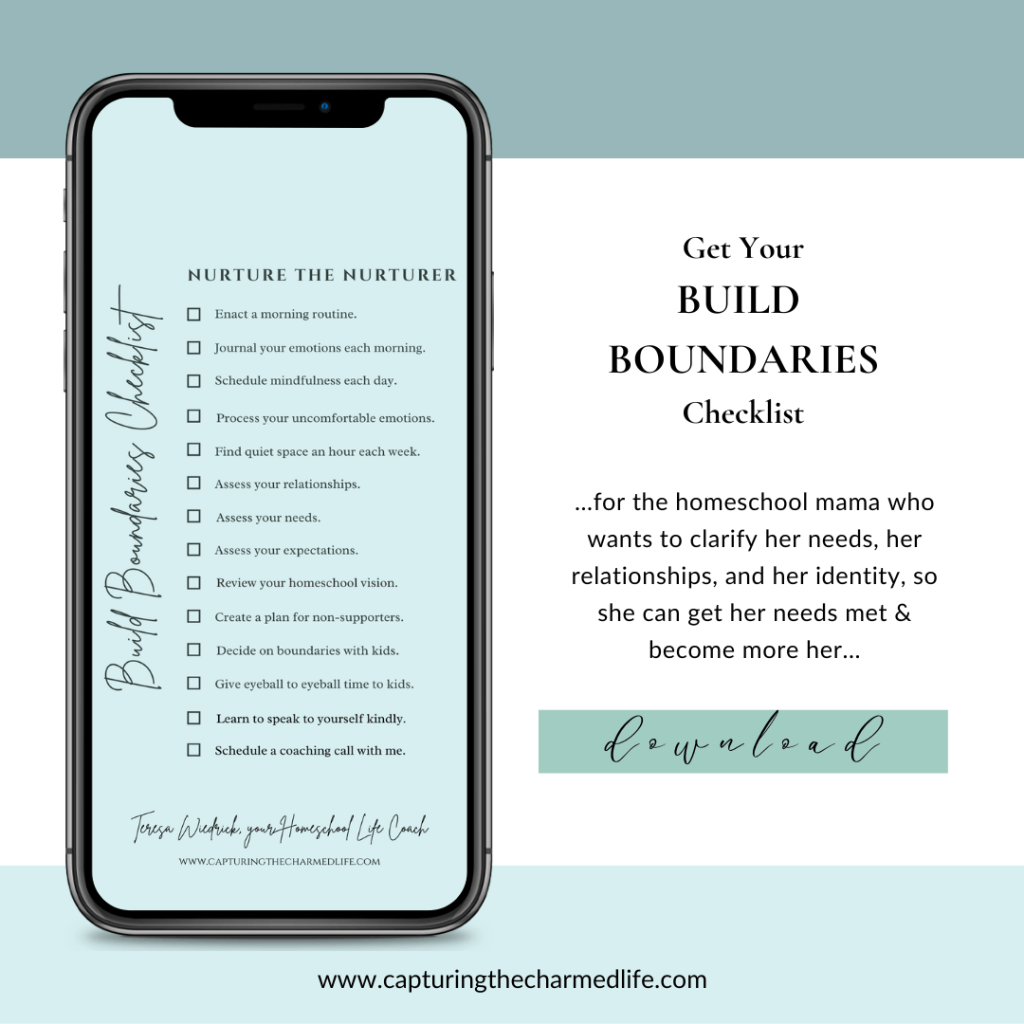We need to plan care for mama as much as we plan for our kids’ education: we need to find quiet, learn to handle overwhelm, and how to build boundaries in your homeschool.
So how do you take care of mama so she can take care of her kids?
You went into this homeschool thing because you love these little voices. So how to build boundaries in your homeschool days?
You love hearing…
- their made-up stories,
- their nighttime dream recounting,
- their Lego plans, their Barbie tales,
- their frustrations with friends,
- and their plans for the future.
You want to hear their voices.
But sometimes you need a little quiet too.
All day, every day you get to hear the sing songy voices, chirpy voices, sweet voices, whining voices, barking voices, and grunting voices of your children: depends on the age, stage and mood. But there’s always voices.
Teresa Wiedrick, author of Homeschool Mama Self-Care: Nurturing the Nurturer
How to build boundaries in your homeschool? Know who you are & who you aren’t.
We love these voices, but we need separateness too. Either we need to take activities off the list, set boundaries so others can learn our needs, or we have to sell a kid. Three options.
One of those options is illegal. The other two: doable! If only we have perspective and a plan.
One of the biggest hurdles to our peace of mind is learning how to exist together. (A common reason parents share why they wouldn’t want to homeschool). Every parent needs to learn how to exist with their kids. Not every parent is present for their child’s twenty-four-hour day.
We need to learn to exist with these different-than-us kids, these sometimes frontal-lobe-challenged kids, these always-needing-something kids.
How to find time alone, handle overwhelm, and build boundaries in your homeschool:
Time alone.
Frankly, whether you see it or not, you need time alone. If you’re in your first six months of homeschooling, you may not identify that, yet. Just like the wedding honeymoon, there’s a homeschool honeymoon.
For some, it is much longer than six months; for some, it’s much shorter.
Whatever the amount of time it takes, we come to understand that homeschooling isn’t a family utopia, and it is most definitely challenging to find alone time.
Alone time, scheduled, in a different location than the kiddos, not just a different room. No child in sightline or yelling range. Quiet facilitates perspective.
Separateness facilitates the desire to be together again.
How does a homeschool mama find time alone?
- Schedule Time in Your Daytimer: Set aside dedicated time in your daily or weekly schedule for personal activities and hobbies, even if it’s just 30 minutes of uninterrupted time each week or month.
- Swap Childcare with Other Homeschool Moms: Collaborate with other homeschooling families to take turns watching each other’s children for an afternoon or sleepover, allowing each mom to have some time away while knowing their kids are safely cared for.
- Involve Family Members or Friends: Reach out to extended family members or close friends who may be willing to help with childcare, allowing you to take go for an afternoon walk break or do errands.
- Schedule errands during kids’ extracurricular activities and include a quiet coffee afterward as you walk a local home store or art gallery, or second-hand shop.
- Consider Online Learning Platforms: Utilize online educational platforms that offer interactive lessons or activities, giving your kids a chance to learn independently while you take a breather.
When you’re alone, you can fuel your creativity. Creative practices are essential for homeschool moms to fuel their joy and happiness because they provide a much-needed outlet for self-expression and rejuvenation.
Engaging in creative activities, whether it’s painting, writing, crafting, or playing an instrument, allows moms to tap into their inner passions and interests beyond the responsibilities of homeschooling.
Creative pursuits inspire a sense of accomplishment and fulfillment, boosting confidence and empowering moms to tackle the challenges of homeschooling with renewed energy.
By nurturing their creativity, homeschool moms model a lifelong love of learning and artistic expression to their children, creating a positive and inspiring learning environment for the whole family.
Ultimately, incorporating creative practices into their daily lives helps homeschool moms find balance, discover new facets of themselves, and foster a joyful and harmonious homeschooling experience.
If you want to facilitate your creativity while you’re alone, you might use these resources:
- food for creative thought: how I incorporate writing into daily life
- finding a writing voice
- After I am Not a Homeschool Mom: If you Hear a Voice Within…
- for those that write, or wanna write: 8 things I tell myself every day
If you want to build boundaries in your homeschool, you need your own thing.
Whatever it is, it needs to be an all about you thing.
Whether it’s a knitting club, a cycling group, a home-based business, a reading checklist, or a full-fledged career, you have to remember to do you. In my first two homeschool years, I sat in Starbucks with a latte and a journal and I wrote. That writing practice was built and built until I was a writer.
The home designing, homestead building, bed and breakfast organizing elements of my life squeezed in there eventually too.
If you’re not energized, you’re surviving, and definitely not thriving.
Value quiet to build boundaries in your homeschool.
In my observation, the longer a family homeschools, the quieter the children become.
I don’t believe this is just because those children are maturing, but rather that parents need separate thinking space and awareness that quietness only happens when you build boundaries toward it. We need our own mental space as we commune in our families.
This is challenging, no matter how hard we try to enact boundaries on noise. It’s a slow process that enables our kids to focus on their work and their play.
They learn to be attentive to friends and non-parental leaders. And they learn to be more empathetic because they listen better.
Here are six ways you can try for quiet in your home:
- Early Morning or Late Evening Quiet Time: Wake up before your kids or stay up after they’ve gone to bed to enjoy some quiet moments for meditation, prayer, or simply to enjoy a peaceful start or end to your day. (But you already know this one!)
- Quiet Reading or Study Corner: Designate a cozy corner in your homeschool area where you can retreat to read a book, study, or engage in quiet activities while the kids are working independently or playing outside.
- Nap/Rest Time: If your children are young or still take naps, use this time to recharge by resting or engaging in quiet activities that help you relax.
- Outdoor Nature Breaks: Take advantage of nature by incorporating regular outdoor breaks into your homeschool routine.
- Audiobooks and Headphones: Encourage your kids to use headphones while listening to audiobooks or educational videos, which allows you to have some quiet time without interruptions.
- Use Quiet Learning Activities: Plan activities that promote focused and quiet engagement, such as journaling, drawing, puzzles, or hands-on crafts. This gives you moments of relative quiet while your kids are engrossed in their tasks.
Daily separateness practice.
Head into your room with a cup of morning coffee and read an inspiring word or two.
Early on, when they’re little, they won’t believe that a closed door means you’re unavailable.
So when they peek their little noses into the doorway, you can ask in your most surprised tone, “Is the house on fire?”
Apparently, the house isn’t on fire and they back out of the doorway. If you’re routinely addressing their needs and listening to their little voices, then practice sitting in your house clothes for just a little while longer.
(It’s not just the homeschooled kiddos that have a hard time getting out of pajamas. Homeschooled mamas have five sets too.)
Recognize where you’re overwhelmed if you want to build boundaries in your homeschool.
Learn to recognize overwhelm in yourself.
- Sit with your feelings more.
- Observe your interior.
- Recognize what the feelings are under the iceberg of frustrated or angry feelings.
Accept your feelings despite their uncomfortableness. Honour those feelings. Attend to them like young children.
Recognize that your feelings pass like a weather system.
And recognize the underlying needs of those feelings.
With kindness and continual efforts, we learn what we need. Some days those lessons need to be learned and relearned.
Rome wasn’t built in a day.
A note on enmeshment.
Recognize that our children’s struggles are not ours.
We were meant to participate in helping to unravel struggles they may have. We are here to offer tools and be a listening ear. But those struggles aren’t ours.
Enmeshment can be a challenge for homeschool moms when they have difficulty separating their own emotions and identity from their children’s struggles and challenges.
It’s natural for parents to want to help and support their children, but enmeshment occurs when they become overly involved in their children’s issues to the point where they lose their own sense of self and well-being.
We need to know how to build boundaries in our homeschools; otherwise, we run the risk of becoming enmeshed:
- Overidentify with their children’s struggles: They feel the same emotions as their children and may take their children’s challenges personally.
- Feel responsible for fixing everything: They believe it’s their duty to solve all their children’s problems, even those that are beyond their control.
- Neglect their own needs: They prioritize their children’s well-being over their own, leading to burnout and emotional exhaustion.
- Have difficulty setting boundaries: They struggle to establish healthy boundaries between themselves and their children, leading to emotional entanglement.
- Feel anxious and overwhelmed: They become overly preoccupied with their children’s struggles, leading to constant worry and stress.
Recognizing that our children’s struggles are not ours is essential for maintaining a healthy and balanced homeschooling experience. While it’s important to offer support and guidance, it’s equally vital to remember that our children are separate individuals with their own experiences and emotions.
By acknowledging this distinction, homeschool moms can better navigate challenges and provide the necessary support without compromising their own well-being.
Though they are our children, they are not us.
Learn more about How to Handle Homeschool Overwhelm.
Or learn more about Practical (& useful) steps to dealing with boundaries in your homeschool
Take care of yourself, practice finding quiet, build boundaries so you can handle overwhelm.
Teresa Wiedrick

Building Boundaries for Homeschool Mama Coaching Course
Begin a transformative journey with the self-directed course, “Foundations of Homeschool Mom Fulfillment: Building Boundaries for the Homeschool Mama.” Tailored for homeschool mamas seeking fulfillment, stronger relationships, and intentional living, this course empowers you to clarify your needs, navigate relationship challenges, and rediscover your identity. With practical tools and actionable steps, this course is designed to address boundary challenges, foster stronger connections, and guide you toward becoming a more intentional and fulfilled version of yourself.
Find more homeschool encouragement here:
- How to Deal with Those (Failure) Days in 5 Easy Steps
- How to Live the Homeschool Balanced Life
- A Homeschool Mom Podcast for Boundary Breakthrough
- How to Develop Boundaries in your Homeschool Life
- Tell me more about the homeschool mama retreat.
- I’m a new homeschooler, are you able to walk alongside me and mentor me?



Great read!!
Thanks. There’s a book I’ve been writing on homeschool mama self-care…soon out.